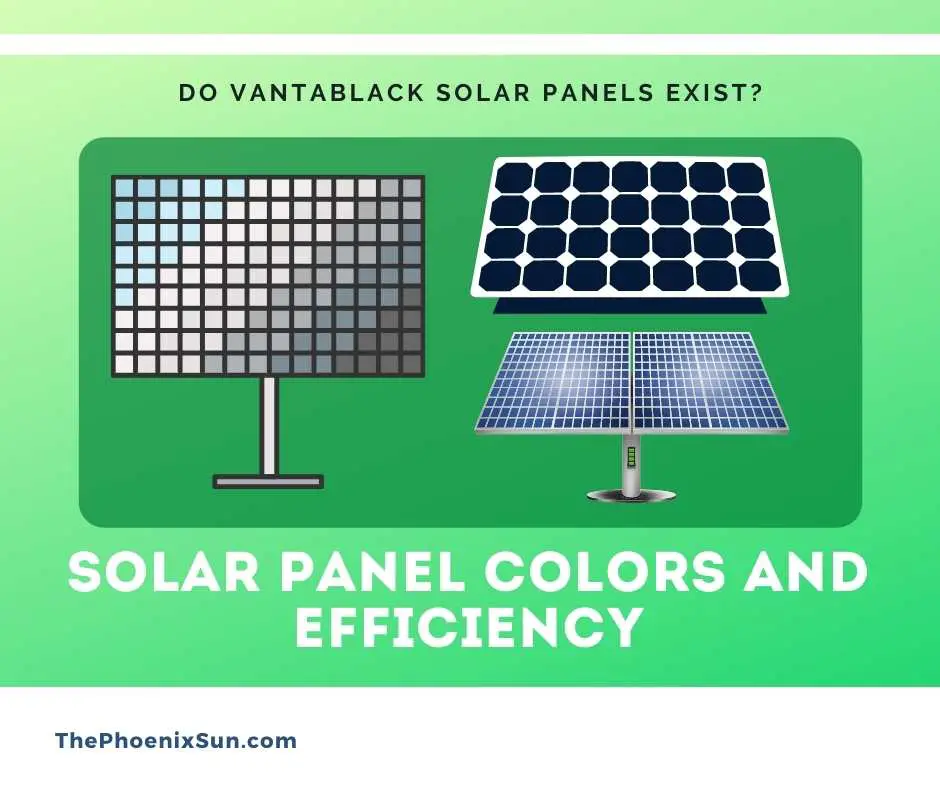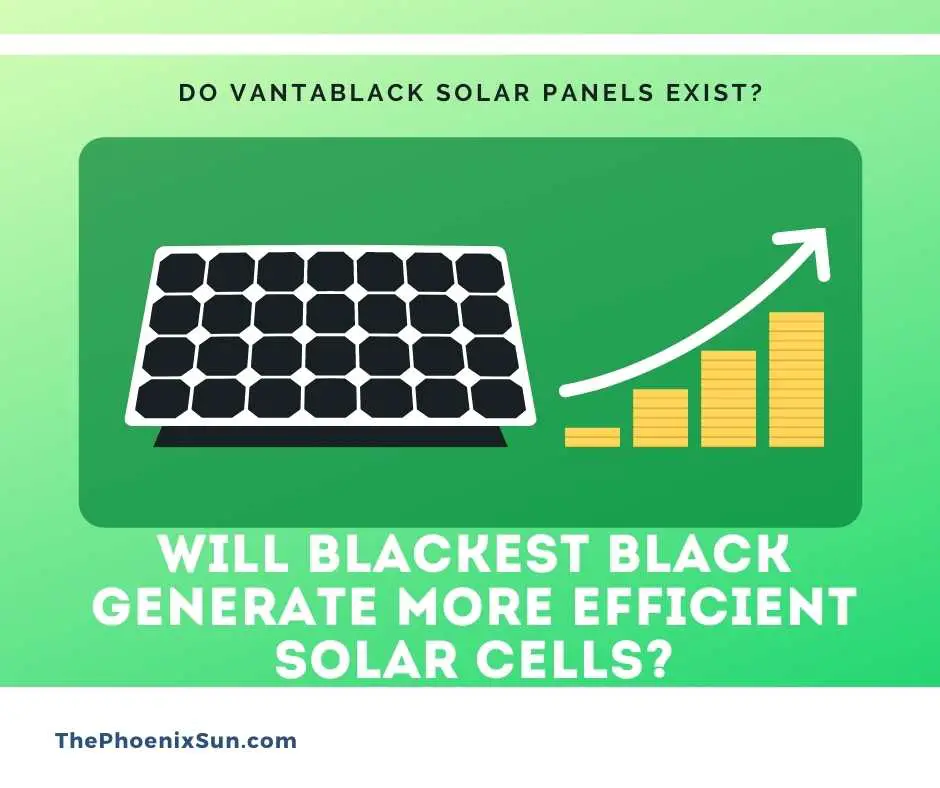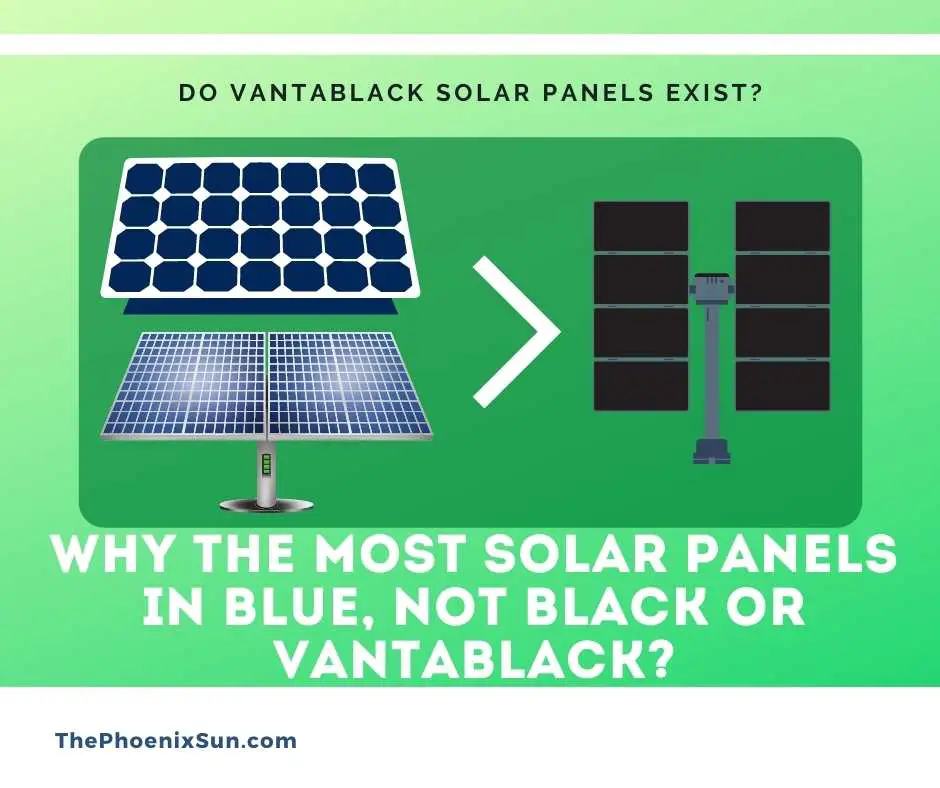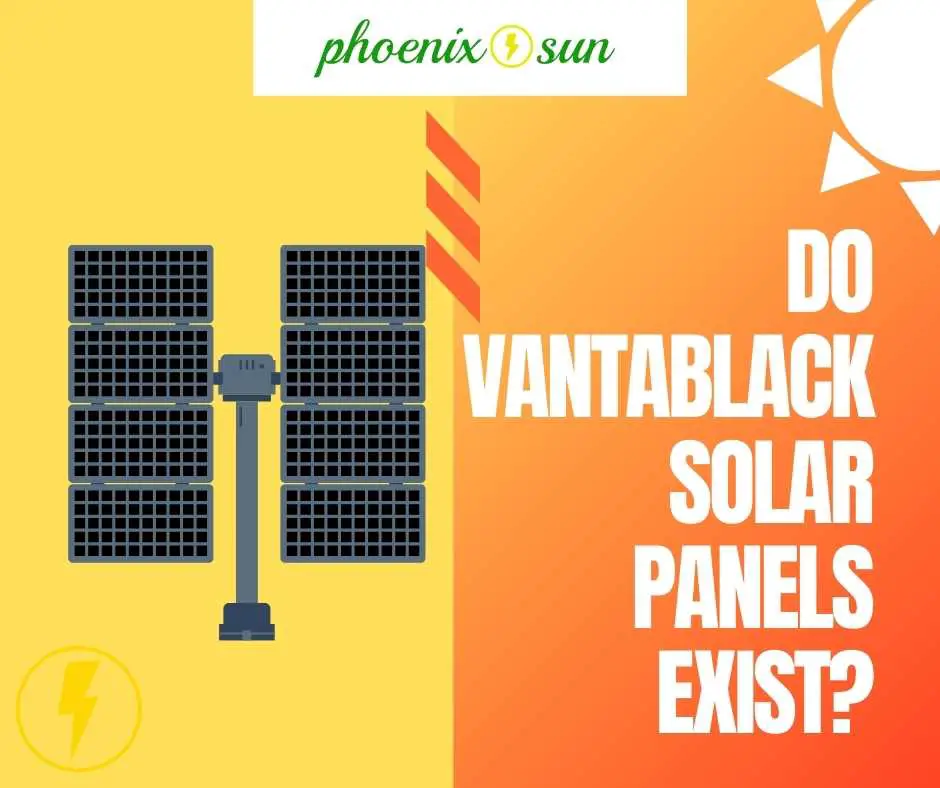The color of the solar panels is one of the major discussions while you are going solar.
Consumers want to explore the most efficient color for their solar panels, and this results in several questions such as do vantablack solar panels exist?
The idea comes from the extreme heat-absorbing power of vantablack materials.
In general, most solar panels come with blue color, and the surface will have a thin glass cover to absorb more power. If vantablack solar panels exist, they will be the most efficient type.
In this writing, we will present the color and efficiency factors of solar panels.
Besides, we will help you understand the efficiency of the blackest black color and the reason for using blue color for solar panels.
Contents
Solar Panel Colors And Efficiency

Solar panels are designed to absorb sunlight and provide heat to the inverter. The surface and the color of the solar panels have a special touch to make the cells more efficient.
The materials of monocrystalline and polycrystalline solar panels play a vital role, but you can not ignore the color of solar panels.
In general, we know that black color absorbs more heat and believes that the black surface will make the solar cells more efficient.
But you can notice that most solar panels come with blue color, and the blue surface is working well in a solar system.
Different colors have separate light-absorbing power, and it will depend on the material on which the color will be applied.
Solar panels’ wattage depends on the number of photovoltaic cells, and the most efficient solar panels contain powerful cells.
In this sense, if you observe the efficiency of a solar panel, then the color factor may enhance the energy production rate.
On the contrary, solar panels are made from silicon, and polycrystalline solar panels are made of raw silicon by molding it with a square mold.
The process can not align silicon perfectly, and many individual silicon crystals are formed in the mold.
The individual silicon has a speckled and glimmering look that converts it to blue color.
So, the blue color of polycrystalline silicon comes from the characteristics of raw silicon.
The monocrystalline solar panels are made of high-quality silicone that has top-level purity.
The molding process and orientation of silicon go the same way, and this type of silicon creates larger crystals.
When the light interacts with a monocrystalline silicon layer, you will see the black color of the surface.
Finally, the efficiency of a solar panel depends on several things, including the production process, materials, wattage, types of silicon, mounting option, and place.
You will get sufficient energy if you install efficient solar panels that have high-quality production materials.
Will blackest black generate more efficient solar cells?

The direct answer to the question is- you can not use the vantablack color for your solar panels.
If you are discussing solar cells and their color, you must consider the efficiency of the solar panels.
The manufacturing process and raw material will set the proficiency and color pattern of a solar panel.
The vantablack is a kind of paint that is perfect for metal surfaces in high-temperature conditions.
This process allows the paint to form carbon nanotubes to absorb more light. It is not suitable for solar panels.
Solar panels are photovoltaic cells made from silicon cells. Vantablack is a color or paint that is applied to metal surfaces.
If you apply vantablack on a solar cell, it will absorb a little bit of extra light from the sun.
It will help you to collect more heat, not more energy. So, the blackest black is not suitable for photovoltaic solar cells.
On the contrary, if you use vantablack paint on the surface of a solar panel, you have to cover the solar panel with a transparent protector to avoid oxidizing on the air.
This process is more costly than conventional silicon solar cells. Besides, you can not get additional energy by installing this protector.
However, the vantablack paint is sometimes applied to collect more heat for the steam solar cooker and kitchen. It is not ideal for regular solar panel manufacture.
The vantablack panels will require more investment than commercially available cells.
If we consider the technical efficiency of the vantablack paint, then it will not cause any massive difference in power production.
It will only increase the heat, which will disappear as heat radiation. The method can be used for water heating purposes but not for generating electrical power.
Finally, the blackest of black is not suitable for producing more energy with a solar panel.
Why the most solar panels in blue, not black or vantablack?

You might have noticed that most of the solar panels have blue surfaces. The black or vantablack is absent for solar cells and panels.
We have discussed above that most of the solar panels are blue because of their manufacturing process.
The characteristics of silicon and the molding process make the solar panels blue.
Polycrystalline solar panels are blue, and it is ideal for commercial and residential purposes.
Let’s explore some significant reasons.
The manufacturing process converts the raw silicon with less crystal effect, and the molding process is not pure enough to produce black color cells.
The raw material polycrystalline solar panel is responsible for this color factor. A solar panel contains blue color because of this manufacturing material.
Affordability makes most of the solar panels blue. Monocrystalline silicon can produce black solar panels, and the production costs of this high-level pure silicon are higher than the polycrystalline silicon.
On the contrary, vantablack solar panels or cells are unavailable because they are paints that can be used only on metal surfaces with high temperatures. It is not ideal for energy production.
The availability of blue polycrystalline solar cells increases the usage of this type of solar panel. Most of the consumers want solar panels that are available in the market for instant installation, exchange.
Durability is one of the most significant reasons for making blue solar panels in the market. You can use a polycrystalline solar panel for 25 to 30 years, and it can serve you in any weather conditions.
The efficiency of blue solar panels makes them more visible on residential and commercial projects.
A blue solar panel can generate more energy through black and absorb more heat.
By considering all the matters and these significant reasons, you can easily understand why most solar panels are blue, not black or vantablack.
We hope you will find the most efficient solar panels for your project and save a massive amount by installing efficient solar cells by considering the above things.
Besides, you can avoid the less efficient and costly ideas like vantablack panels to estimate the most accurate installation costs.
Conclusion
Altogether, it is clear that vantablack solar panels do not exist in the market, and it is not ideal for energy production.
You will find most of the solar panels that are made with polycrystalline silicon and blue. Try to find the most effective solar panels for your energy solutions. It will produce sufficient energy for your home.

What if vantablack was applied below the panels and the cells are
Spaced or panels redesigned in a honeycomb pattern with a central hexagon cell missing to draw light
Using the vantablack below would that give the the surrounding cells any gain of function
Have you considered how efficient vanta black would make solar water panels? In some countries solar water heating is more efficient than photovoltaic.